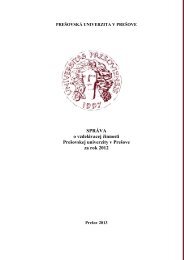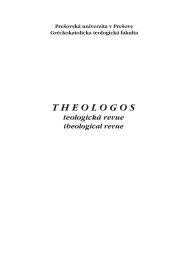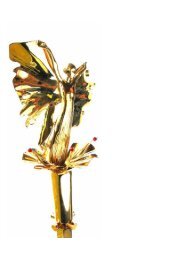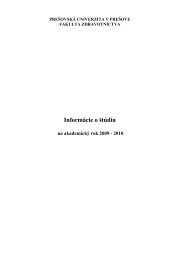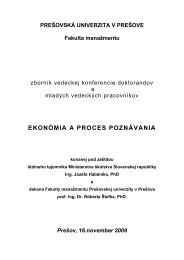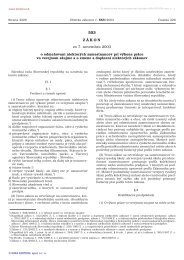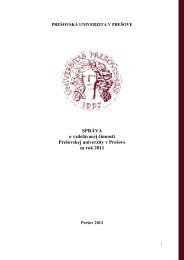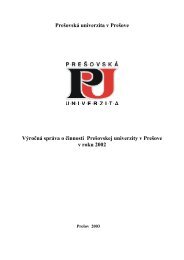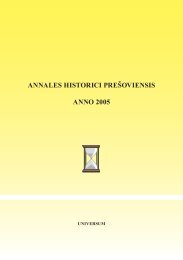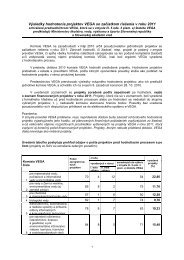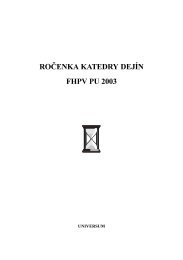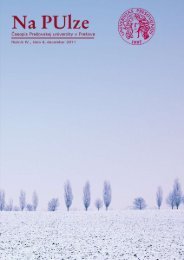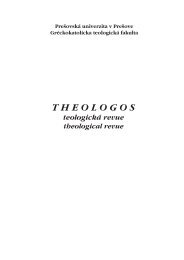- Page 1 and 2: ANNALES HISTORICI PRESOVIENSES 7 UN
- Page 3 and 4: OBSAH ŠTÚDIE Henrieta Lisková: Z
- Page 5: ŠTÚDIE ARTICLES
- Page 8 and 9: Henrieta Lisková 1) s pramennou ed
- Page 10 and 11: Henrieta Lisková O pôvodnej slove
- Page 12 and 13: Henrieta Lisková Výsadná vrstva
- Page 14 and 15: Henrieta Lisková Pri niektorých
- Page 16 and 17: Henrieta Lisková V roku 1489 cesto
- Page 18 and 19: Henrieta Lisková mu v niektorom z
- Page 20 and 21: Henrieta Lisková do mestskej pokla
- Page 22 and 23: Henrieta Lisková Stavebné úpravy
- Page 24 and 25: Henrieta Lisková listiny, ktoré m
- Page 28 and 29: Patrik Kunec ský historik József
- Page 30 and 31: Patrik Kunec Od roku 1765 sa Michal
- Page 32 and 33: Patrik Kunec ad formandos Tyrones,
- Page 34 and 35: Patrik Kunec tým, že sa na svojic
- Page 36 and 37: Patrik Kunec covi) Pierrom Philippo
- Page 38 and 39: Hospodárske pomery v Michalovciach
- Page 40 and 41: Peter Kónya me ich prílišná ang
- Page 42 and 43: Peter Kónya viacero výhod, ktoré
- Page 44 and 45: Peter Kónya Bližšie údaje z toh
- Page 46 and 47: Peter Kónya kych usadlostí na 15,
- Page 48 and 49: Peter Kónya malšie ako poľnohosp
- Page 50 and 51: Peter Kónya Významné dôchodky p
- Page 52 and 53: Peter Kónya Neurbárski poddaní,
- Page 54 and 55: Peter Kónya aj lúky s nerovnakou
- Page 56 and 57: Peter Kónya Jeho súčasťou boli
- Page 58 and 59: Peter Kónya Zo spomínaných štyr
- Page 60 and 61: Kráľovské katolícke vyššie gy
- Page 62 and 63: Annamária Kónyová budova Kráľo
- Page 64 and 65: Annamária Kónyová Učebný plán
- Page 66 and 67: Annamária Kónyová Vysoké Tatry
- Page 68 and 69: Annamária Kónyová šok. Súkromn
- Page 70 and 71: Annamária Kónyová 10 % tvorili
- Page 72 and 73: Annamária Kónyová Podiel jednotl
- Page 74 and 75: Annamária Kónyová Krasopis by sm
- Page 76 and 77:
Annamária Kónyová maximálne vyu
- Page 78 and 79:
Ján Mojdis nevynímajúc Slovákov
- Page 80 and 81:
Ján Mojdis by sme zabúdať aj na
- Page 82 and 83:
Ján Mojdis vyplýva z toho, že te
- Page 84 and 85:
Ján Mojdis však stretávalo čast
- Page 86 and 87:
Totalitné snahy Deutsche Partei na
- Page 88 and 89:
Michal Schvarc ochotu splynúť s D
- Page 90 and 91:
Michal Schvarc korporácií. Myšli
- Page 92 and 93:
Michal Schvarc Tieto okolnosti povz
- Page 94 and 95:
Michal Schvarc ruchu. Jedným z hla
- Page 96 and 97:
Michal Schvarc denia neprijali. 54
- Page 98 and 99:
Michal Schvarc dajší vládny komi
- Page 100 and 101:
Michal Schvarc vylúčení z DP. 77
- Page 102 and 103:
Michal Schvarc štancií, lebo „b
- Page 104 and 105:
104
- Page 107 and 108:
Filozofia a hesychia, scholastika a
- Page 109 and 110:
Filozofia a hesychia, scholastika a
- Page 111 and 112:
Filozofia a hesychia, scholastika a
- Page 113 and 114:
Filozofia a hesychia, scholastika a
- Page 115 and 116:
Filozofia a hesychia, scholastika a
- Page 117 and 118:
Filozofia a hesychia, scholastika a
- Page 119 and 120:
Filozofia a hesychia, scholastika a
- Page 121 and 122:
Filozofia a hesychia, scholastika a
- Page 123 and 124:
Filozofia a hesychia, scholastika a
- Page 125 and 126:
Filozofia a hesychia, scholastika a
- Page 127 and 128:
Filozofia a hesychia, scholastika a
- Page 129 and 130:
Filozofia a hesychia, scholastika a
- Page 131 and 132:
Filozofia a hesychia, scholastika a
- Page 133 and 134:
Geórgios Gemisthos Pléthon: Slovo
- Page 135 and 136:
Geórgios Gemisthos Pléthon: Slovo
- Page 137 and 138:
Geórgios Gemisthos Pléthon: Slovo
- Page 139 and 140:
Geórgios Gemisthos Pléthon: Slovo
- Page 141 and 142:
Geórgios Gemisthos Pléthon: Slovo
- Page 143 and 144:
K otázke Náboženského fondu a U
- Page 145 and 146:
K otázke Náboženského fondu a U
- Page 147 and 148:
K otázke Náboženského fondu a U
- Page 149 and 150:
K otázke Náboženského fondu a U
- Page 151 and 152:
K otázke Náboženského fondu a U
- Page 153 and 154:
K otázke Náboženského fondu a U
- Page 155 and 156:
K otázke Náboženského fondu a U
- Page 157 and 158:
Organizácia a štruktúra slobodom
- Page 159 and 160:
Organizácia a štruktúra slobodom
- Page 161 and 162:
Organizácia a štruktúra slobodom
- Page 163 and 164:
Organizácia a štruktúra slobodom
- Page 165 and 166:
Organizácia a štruktúra slobodom
- Page 167 and 168:
Organizácia a štruktúra slobodom
- Page 169 and 170:
Organizácia a štruktúra slobodom
- Page 171 and 172:
Organizácia a štruktúra slobodom
- Page 173 and 174:
Organizácia a štruktúra slobodom
- Page 175 and 176:
Vysťahovalectvo z východného Slo
- Page 177 and 178:
Vysťahovalectvo z východného Slo
- Page 179 and 180:
Vysťahovalectvo z východného Slo
- Page 181 and 182:
Vysťahovalectvo z východného Slo
- Page 183 and 184:
Vysťahovalectvo z východného Slo
- Page 185 and 186:
Vysťahovalectvo z východného Slo
- Page 187 and 188:
Vysťahovalectvo z východného Slo
- Page 189 and 190:
Vysťahovalectvo z východného Slo
- Page 191 and 192:
Vysťahovalectvo z východného Slo
- Page 193 and 194:
Vysťahovalectvo z východného Slo
- Page 195 and 196:
Vysťahovalectvo z východného Slo
- Page 197 and 198:
Vysťahovalectvo z východného Slo
- Page 199 and 200:
Vysťahovalectvo z východného Slo
- Page 201 and 202:
Vysťahovalectvo z východného Slo
- Page 203 and 204:
Vysťahovalectvo z východného Slo
- Page 205 and 206:
Vysťahovalectvo z východného Slo
- Page 207 and 208:
Vysťahovalectvo z východného Slo
- Page 209 and 210:
Vysťahovalectvo z východného Slo
- Page 211 and 212:
Vysťahovalectvo z východného Slo
- Page 213 and 214:
Vysťahovalectvo z východného Slo
- Page 215 and 216:
Vysťahovalectvo z východného Slo
- Page 217 and 218:
Vysťahovalectvo z východného Slo
- Page 219 and 220:
Vysťahovalectvo z východného Slo
- Page 221 and 222:
Tragický konflikt v Nižnom Šebe
- Page 223 and 224:
Tragický konflikt v Nižnom Šebe
- Page 225 and 226:
Tragický konflikt v Nižnom Šebe
- Page 227 and 228:
Tragický konflikt v Nižnom Šebe
- Page 229 and 230:
Tragický konflikt v Nižnom Šebe
- Page 231 and 232:
Tragický konflikt v Nižnom Šebe
- Page 233 and 234:
Tragický konflikt v Nižnom Šebe
- Page 235 and 236:
Tragický konflikt v Nižnom Šebe
- Page 237 and 238:
Tragický konflikt v Nižnom Šebe
- Page 239 and 240:
Tragický konflikt v Nižnom Šebe
- Page 241 and 242:
Vývoj školstva v okrese Svidník
- Page 243 and 244:
Vývoj školstva v okrese Svidník
- Page 245 and 246:
Vývoj školstva v okrese Svidník
- Page 247 and 248:
Vývoj školstva v okrese Svidník
- Page 249 and 250:
Vývoj školstva v okrese Svidník
- Page 251 and 252:
Vývoj školstva v okrese Svidník
- Page 253 and 254:
Vývoj školstva v okrese Svidník
- Page 255 and 256:
Vývoj školstva v okrese Svidník
- Page 257 and 258:
Vývoj školstva v okrese Svidník
- Page 259 and 260:
Vývoj školstva v okrese Svidník
- Page 261 and 262:
Vývoj školstva v okrese Svidník
- Page 263 and 264:
Inštitucionálny projekt FF PU v P
- Page 265 and 266:
Osobnosti ruskej emigrantskej komun
- Page 267 and 268:
Osobnosti ruskej emigrantskej komun
- Page 269 and 270:
Osobnosti ruskej emigrantskej komun
- Page 271 and 272:
Osobnosti ruskej emigrantskej komun
- Page 273 and 274:
Obraz ruskej emigrácie na stránka
- Page 275 and 276:
Obraz ruskej emigrácie na stránka
- Page 277 and 278:
Obraz ruskej emigrácie na stránka
- Page 279 and 280:
Súpis prameňov k pôsobeniu polit
- Page 281 and 282:
Súpis prameňov k pôsobeniu polit
- Page 283:
KRONIKA, RECENZIE, GLOSY CHRONICLE,
- Page 286 and 287:
titul univerzitnej profesorky a v r
- Page 288 and 289:
a východnej Európe (Aarhus/Dánsk
- Page 290 and 291:
K životnému jubileu doc. PhDr. Ma
- Page 292 and 293:
Konferencia Slovenská republika 19
- Page 294 and 295:
Cirkvi a ich vplyv na formovanie n
- Page 296 and 297:
ký systém sformovaný na Slovensk
- Page 298 and 299:
možné z časových dôvodov absol
- Page 300 and 301:
und nationale Identität in Ungarn
- Page 302 and 303:
sogar innenpolitische Krisen hervor
- Page 304 and 305:
Slovensku a v Prešove a v 50. - 80
- Page 306 and 307:
spoločenskú, politickú, cirkevn
- Page 308 and 309:
ša príspevok JUDr. Dezider Obetk
- Page 310 and 311:
KOSZTA, László: Capitulum III. Í
- Page 312 and 313:
Svätec a jeho funkcie v spoločnos
- Page 314 and 315:
na poli diplomatiky, paleografie, e
- Page 316 and 317:
en identifizierten sich mit dem Vol
- Page 318 and 319:
MARINELLI-KÖNIG, Gertraud: Oberung
- Page 320:
ANNALES HISTORICI PRESOVIENSES VOL.



